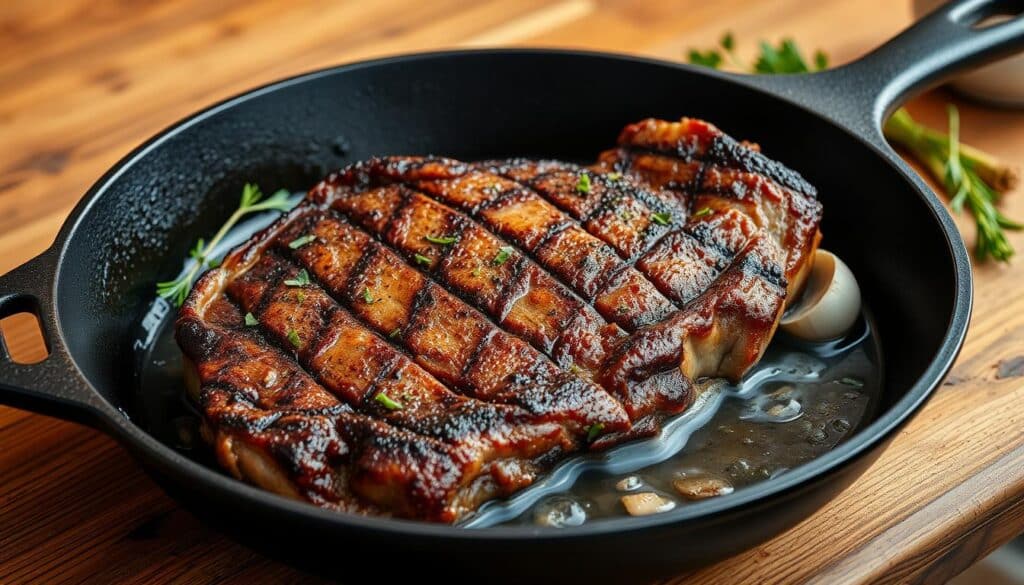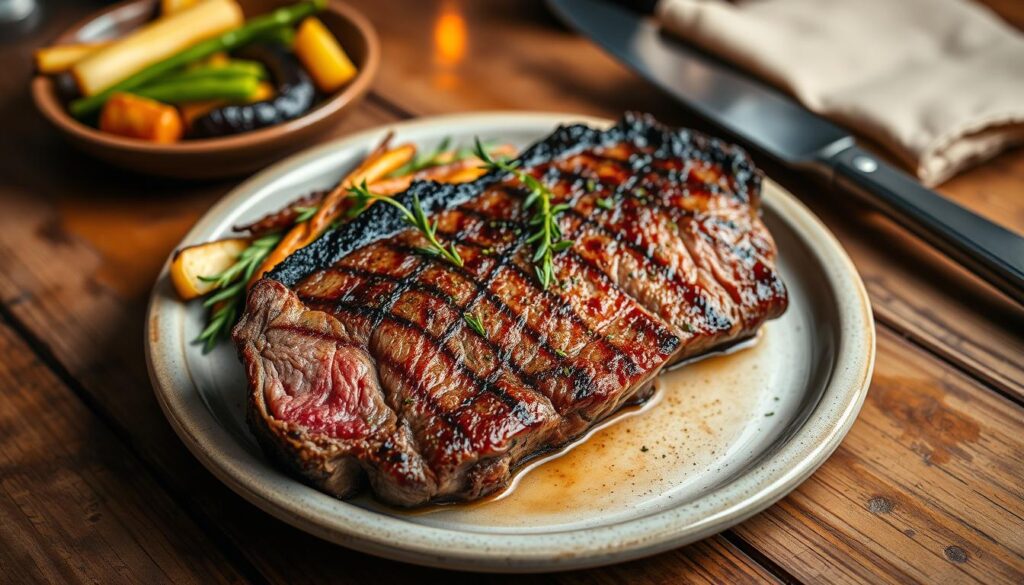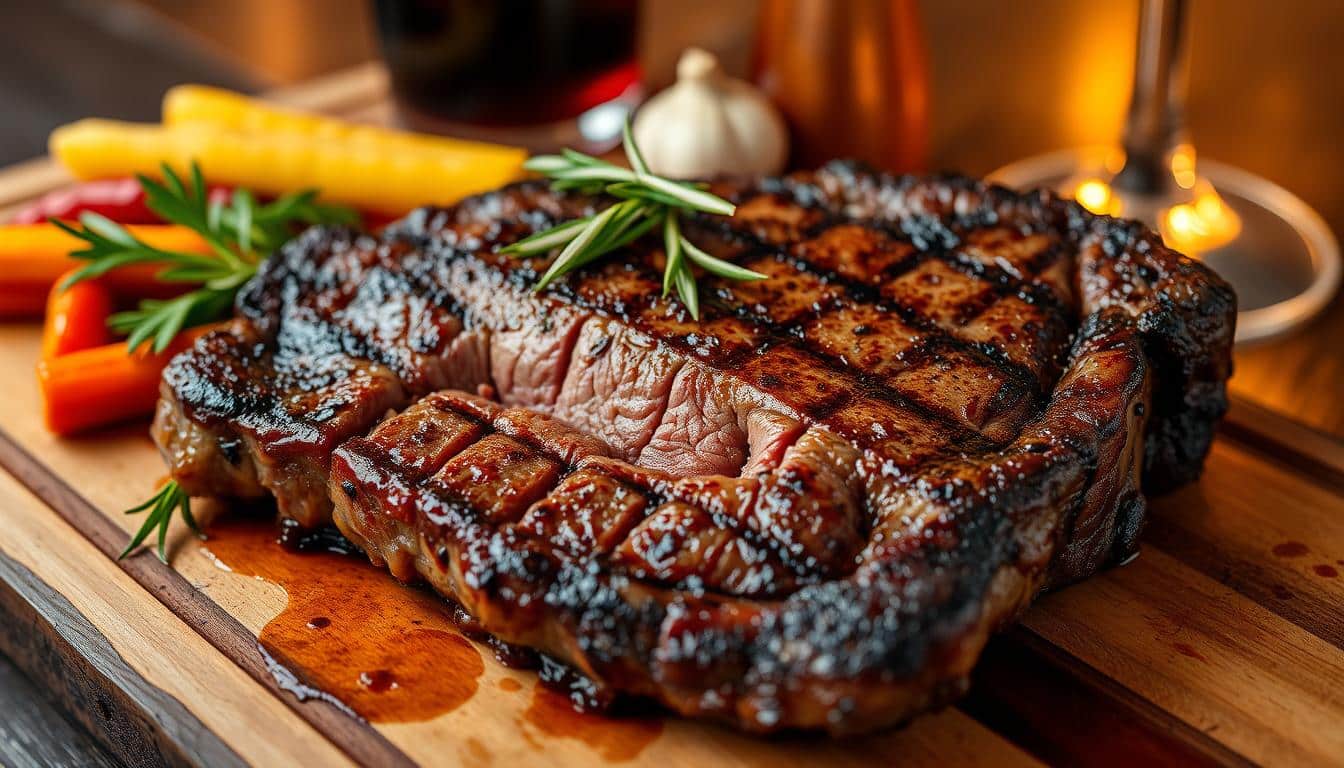Cooking steak at home can really boost your cooking skills. We’ll show you how to make a steak as good as those in fancy restaurants. Our recipe will make you a pro at cooking steak, impressing everyone with your skills.
To cook a great steak, you need three things: the right cut, good seasoning, and the right cooking method. Focus on these, and you’ll make a steak that’s as tasty as any in a top steakhouse.
Do you like a juicy ribeye or a tender filet mignon? Our recipe will help your steak turn out amazing. Let’s explore how to make your steak dishes even better.For a flavorful twist, explore our Steak Fra Diavolo Recipe, featuring a spicy tomato sauce. View Recipe.
Understanding Different Cuts of Premium Beef
Exploring premium beef cuts shows a wide range of tastes and textures. We’ll look at the most loved steak types. Each has special qualities that make it great in different dishes.
Ribeye: The Marbled Marvel
Ribeye is known for its rich marbling. This makes it juicy and full of flavor. It comes from the rib section of the cow.
For a perfect ribeye, sear it on high heat. This creates a caramelized crust. At the same time, it keeps the inside tender.
Filet Mignon: The Tender Classic
Filet mignon is the most tender beef cut. It’s lean and has a mild flavor. A classic recipe involves pan-searing and then baking in the oven.
New York Strip: The Steakhouse Favorite
The New York Strip is a favorite for its flavor and tenderness. It’s cut from the short loin. It has a firmer texture than ribeye.
Grilling is the best way to cook it. It creates a delicious crust.
T-Bone and Porterhouse: Two-in-One Experience
These cuts have two steaks in one. The T-bone has a strip steak and a smaller tenderloin. The Porterhouse has a bigger tenderloin.
Both are best grilled or broiled. This highlights their unique textures.
| Cut | Marbling | Tenderness | Best Cooking Method |
|---|---|---|---|
| Ribeye | High | Medium | Pan-sear or Grill |
| Filet Mignon | Low | High | Pan-sear and Oven finish |
| New York Strip | Medium | Medium | Grill |
| T-Bone/Porterhouse | Varied | Varied | Grill or Broil |
Essential Tools and Equipment for Steak Preparation
Great steak starts with the right tools. We’ve listed must-have equipment for top results at home.For seafood lovers, consider our Long John Silver’s Batter Recipe, perfect for creating crispy fish at home. View Recipe.

A high-quality cast iron skillet is key for searing steaks. It keeps heat even, giving that golden crust. A reliable meat thermometer is also vital. It ensures your steak is cooked just right every time.
Sturdy tongs are a must for handling steaks safely. They let you flip and move the meat without losing juices. A sharp chef’s knife is also essential. It makes clean cuts, both during prep and when serving.
- Cast iron skillet
- Meat thermometer
- Sturdy tongs
- Sharp chef’s knife
With these tools, you’re ready to tackle any steak recipe. Quality equipment and the right technique lead to delicious results.
The Ultimate Steak Recipe for Restaurant-Quality Results
Want a restaurant-quality steak at home? We’ve got the ultimate recipe for you. Follow this guide for mouthwatering results every time.
Preparing Your Meat
First, pick a high-quality beef cut. Take it out of the fridge 30 minutes before cooking. This ensures it cooks evenly.
Pat the steak dry with paper towels. This helps get a perfect sear.
Seasoning Techniques
Use salt and pepper, or try a custom mix. Season both sides of the steak well. Press the spices into the meat for extra flavor.
For more taste, add garlic powder or dried herbs.
Cooking Methods Overview
There are many ways to cook a steak perfectly. Here’s a quick look at popular methods:
| Method | Best For | Cooking Time |
|---|---|---|
| Pan-Searing | Thick cuts | 8-12 minutes |
| Grilling | Outdoor cooking | 6-10 minutes |
| Broiling | Thin cuts | 4-6 minutes |
| Sous Vide | Precise doneness | 1-4 hours |
With these tips, you’re set to make a restaurant-quality steak at home. Try different methods to find your favorite.
Mastering the Perfect Steak Temperature
Getting the steak just right is key for a great meal. We’ll show you how to cook your steak to perfection, from rare to well-done.
Rare to Well-Done Guidelines
Steak temperature depends on what you like. Rare steaks should be 125°F (52°C). Medium-rare is 135°F (57°C), and medium is 145°F (63°C).
Medium-well is 150°F (66°C), and well-done is 160°F (71°C). Remember, the steak will keep cooking after you take it off the heat.
A good meat thermometer is a must for exact cooking. Stick it into the thickest part of the steak, away from fat or bone. For thin steaks, use an instant-read thermometer to avoid overcooking.
Digital thermometers give quick and accurate readings.
Resting Time Importance
Letting your steak rest is key for keeping it juicy. After cooking, let it sit for 5-10 minutes. This lets the juices spread out, making the steak tender and tasty. Pair your steak with refreshing options from our Dessert & Juices Collection, ideal for a balanced meal. View Recipes.
The steak’s temperature will go up a bit while it rests. So, take it off the heat a few degrees before your target.
| Doneness | Temperature | Resting Time |
|---|---|---|
| Rare | 125°F (52°C) | 5 minutes |
| Medium-Rare | 135°F (57°C) | 5-7 minutes |
| Medium | 145°F (63°C) | 7-8 minutes |
| Well-Done | 160°F (71°C) | 8-10 minutes |
Mastering steak temperature and using a meat thermometer will help you make steaks that wow everyone.
Professional Steak Seasoning Techniques
Professional chefs know how to make steak taste amazing. They use special seasoning techniques to bring out the best in beef. Let’s look at some expert ways to make your steak truly special.
Dry rubs are a favorite way to season steak. They mix herbs and spices to create a tasty crust. A basic dry rub might have salt, black pepper, garlic powder, and paprika. For more flavor, add cumin or chili powder.
Marinades are another great way to season steak. They mix oil, acid, and spices to tenderize and flavor the meat. A simple marinade is olive oil, balsamic vinegar, garlic, and herbs like rosemary or thyme.
Some chefs like to keep it simple. They just use coarse salt and black pepper. This lets the steak’s natural taste stand out. Season generously right before cooking for the best taste.
“The key to perfect steak seasoning is balance. You want to enhance the meat’s flavor, not overpower it.”
Try out these seasoning methods to find what you like best. The goal is to add to the steak’s flavor, not hide it.
| Seasoning Method | Ingredients | Application Time |
|---|---|---|
| Dry Rub | Salt, pepper, garlic powder, paprika | 30 minutes before cooking |
| Marinade | Oil, vinegar, herbs, garlic | 2-8 hours before cooking |
| Salt and Pepper | Coarse salt, freshly ground black pepper | Just before cooking |
Pan-Searing vs. Grilling Methods
Cooking the perfect steak is a choice between pan-searing and grilling. Each method brings unique flavors and textures. They suit different tastes and cooking settings.
Cast Iron Skillet Technique
Pan-seared steak gets a tasty crust in a cast iron skillet. We heat the skillet until it’s very hot. Then, we add oil that can handle high heat.
The steak sizzles right away, making a flavorful crust. We flip it halfway to cook evenly.

Grilling Temperature Control
Grilling steak needs careful temperature control. We heat the grill to a high setting. This creates zones for searing and finishing.
The first high heat sears the steak’s outside. Then, we lower the heat for even cooking without burning.
Direct vs. Indirect Heat
Knowing about heat zones is key for grilling steak. Direct heat from flames gives a charred outside. Indirect heat cooks the steak without scorching.
We use direct heat for quick-cooking cuts. For thicker steaks, we choose indirect heat.
| Method | Pros | Cons |
|---|---|---|
| Pan-Seared Steak | Even crust, year-round cooking | Limited size, possible smoke |
| Grilling Steak | Smoky flavor, cooks more at once | Weather can affect it, flare-ups are a risk |
Both methods can make delicious steaks. Your choice depends on what you like, what you have, and the flavor you want.
Creating Complementary Steak Marinades
A great steak marinade can make your meal amazing. We’ve mastered the art of marinating to bring out the best in every beef cut. Let’s explore some tasty recipes and tips for the perfect marinade.
First, let’s look at a classic marinade recipe that works well with most cuts:
- 1/4 cup olive oil
- 1/4 cup soy sauce
- 2 tablespoons Worcestershire sauce
- 2 cloves minced garlic
- 1 tablespoon fresh lemon juice
- 1 teaspoon dried herbs (thyme, rosemary, or oregano)
Mix these ingredients and let your steak soak for 2-4 hours. For tougher cuts like skirt steak, marinate up to 8 hours for extra tenderness.
Remember these key points for marinating techniques:
- Always marinate in the refrigerator to prevent bacterial growth.
- Use a non-reactive container (glass, ceramic, or plastic) to avoid metallic flavors.
- Pat the steak dry before cooking to ensure a good sear.
Different cuts of steak need different marinades. Here’s a quick guide:
| Cut | Marinade Type | Time |
|---|---|---|
| Ribeye | Light, herb-based | 30 minutes – 2 hours |
| Sirloin | Bold, acidic | 2 – 4 hours |
| Flank | Tenderizing (with papaya or pineapple) | 4 – 8 hours |
Try different marinades to find your favorite. The goal is to enhance, not overpower, the beef’s natural flavor.
The Reverse-Sear Method Explained
The reverse-sear method is changing how we cook steak. It’s a new way to make steaks that always turn out great.

Temperature Control Steps
First, heat your oven to 250°F. Put your steak on a wire rack in a baking sheet. Cook it until it’s 10-15 degrees below your final temperature.
Timing and Technique
The oven time depends on your steak’s thickness. A 1-inch steak cooks for about 45 minutes to an hour. Use a meat thermometer to check the temperature.
When it hits your target, take it out of the oven. Let it rest for a few minutes.
Finishing Touches
Next, sear the steak. Heat a cast-iron skillet until it’s very hot. Add oil and sear the steak for 45 seconds on each side.
This step makes the steak’s outside crispy and flavorful. It’s a technique that makes your steak perfect every time.
Common Steak Cooking Mistakes to Avoid
We’ve all been there – a perfectly good steak ruined by simple cooking errors. Let’s explore some common steak cooking mistakes and learn how to avoid them for mouthwatering results every time.
One big mistake is not letting the meat come to room temperature before cooking. This can lead to uneven cooking and a less tender result. Take your steak out of the fridge about 30 minutes before cooking to ensure even heat distribution.
Another frequent error is overcrowding the pan or grill. This drops the cooking temperature and can cause the steak to steam instead of sear. Give each steak plenty of space for that perfect crust.
Many home cooks flip their steaks too often. Resist the urge! Flip only once to achieve that coveted golden-brown crust. Here’s a handy table of cooking tips to keep in mind:
| Cooking Tip | Why It Matters |
|---|---|
| Pat steak dry before cooking | Ensures better searing and crust formation |
| Use high heat for searing | Creates flavorful crust and locks in juices |
| Let steak rest after cooking | Allows juices to redistribute for optimal tenderness |
| Season generously | Enhances flavor throughout the meat |
By avoiding these common pitfalls and following our cooking tips, you’ll be well on your way to preparing restaurant-quality steaks at home. Remember, practice makes perfect, so don’t be afraid to experiment and refine your technique.
Conclusion
We’ve looked into making the perfect steak recipe. This includes picking top cuts and learning how to cook them. With practice and trying new things, you can make great steaks at home.
Getting the perfect steak is more than just cooking time. It’s about controlling the temperature and letting it rest. You also need the right tools. Pan-searing or grilling can make your steak taste better.
Keep trying new things in your cooking. Try the reverse-sear method or make your own marinades. With patience and care, you’ll impress everyone with your steak skills. Happy cooking!

